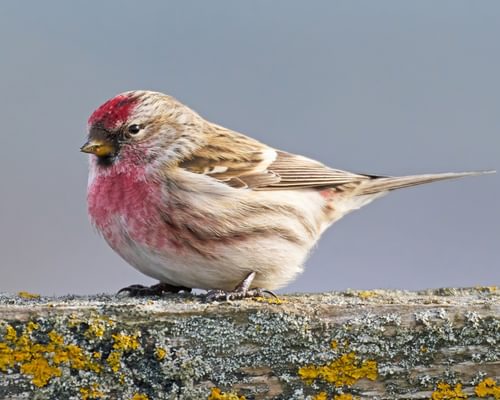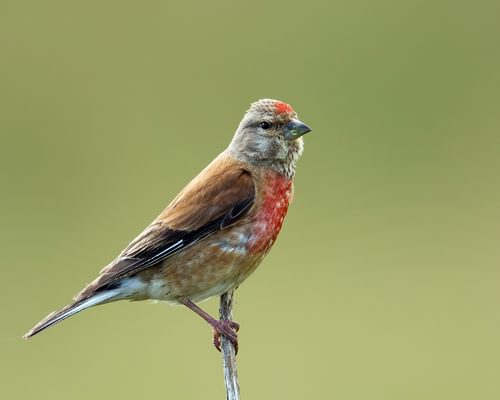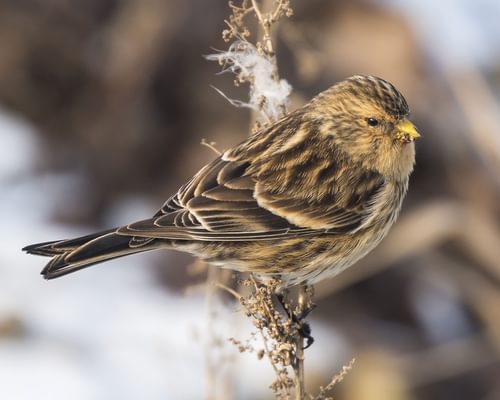Lesser Redpoll
Not EvaluatedAcanthis cabaret
Visual Identification
Appearance
The Lesser Redpoll is a small, streaky finch with a distinctive red forehead patch. Its brown upperparts are heavily streaked, contrasting with a paler, streaked underside. Males have a rosy-red breast and rump, which is especially prominent during the breeding season.
Females are similar but lack the red breast, showing only a hint of pink on the face. Juveniles resemble females but lack the red forehead patch. Winter plumage in both sexes is generally duller.
Size
Length
11cm to 13cm
Wingspan
20cm to 22.5cm
Weight
9g to 12g
Colours
Males and females have similar plumage
Primary Colour
Brown Red
Secondary Colour
White Buff
Beak Colour
Yellow
Leg Colour
Brown
Habitat and Distribution
Habitats
Woodland
Garden
Wetland
Coastal
Urban
Farmland
Grassland
Desert
Tundra
Rainforest
Mountain
Savanna
Distribution
Lesser Redpolls inhabit open woodlands, particularly those with birch and alder trees. They are also found in parks, gardens, and coniferous plantations. Their range extends across much of northern Europe, including the UK and Ireland.
During winter, many birds move southward within Europe, with some reaching as far as southern France and northern Italy. They are year-round residents in the UK but show local movements in search of food.
In the UK, prime breeding areas for lesser redpolls are found in Scotland, Wales and northern and eastern England. Fewer breeding grounds are located in central, southern, and southwest England. However, some nesting occurs in these regions, and there is an increased presence of the species in these areas during the winter months.
Elevation Range
Sea level to 2,000 meters
Climate zones
Temperate, Subarctic
Distribution Map
This map gives you a rough idea of where you might spot a Lesser Redpoll. The coloured areas show countries where these birds have been seen.
A few things to keep in mind:
- Birds might not be everywhere in the coloured areas, for example, they may be present around the coast of that country
- Where birds live can change with seasons and available food
- This map is quite simple - it doesn't show exact locations
We're working on making our maps even better! Soon, we hope to show you:
- More detailed maps for bigger countries, including state and region
- How birds move around during different seasons
Distribution by Region
Behaviour and Ecology
Bird Attributes
This feature is in beta. We'd love your feedback to improve it!
Share your thoughtsBird Attributes Explained
Our bird attributes system rates various aspects of a bird's capabilities on a scale of 0-100, based on data from field observations, scientific studies, and expert knowledge.
Attribute Categories:
- Agility: Manoeuvrability, speed, and grace in flight or movement.
- Strength: Physical power, often correlating with size and hunting abilities.
- Adaptability: Ability to thrive in various environments or changing conditions.
- Aggressiveness: Territorial behaviour and assertiveness, particularly during breeding seasons.
- Endurance: Stamina, often seen in migration patterns or foraging behaviours.
Understanding the Ratings:
- 0-20: Very Low
- 21-40: Low
- 41-60: Average
- 61-80: High
- 81-100: Very High
Remember, these attributes are relative to other bird species and don't necessarily indicate superiority.
Hover over the icon next to each attribute for more information.
Tap the icon next to each attribute for more information.
Agility
Reflects the bird's manoeuvrability, speed, and grace in flight or movement.
The Lesser Redpoll demonstrates remarkable agility, particularly in its acrobatic feeding behaviour. Its ability to hang upside-down whilst foraging and perform elaborate flight displays during courtship indicates a high level of manoeuvrability and aerial prowess.
Strength
Indicates the bird's physical power, often correlating with size and hunting abilities.
As a small finch weighing only 9-12 grams, the Lesser Redpoll has limited physical strength. However, its ability to extract seeds from small cones and catkins suggests some degree of specialised strength in its beak and neck muscles.
Adaptability
Represents the bird's ability to thrive in various environments or changing conditions.
Lesser Redpolls show considerable adaptability, inhabiting various environments from sea level to 2,000 metres elevation. Their ability to survive extreme cold temperatures (down to -50°C) and form mixed flocks with other species demonstrates significant adaptive capabilities.
Aggressiveness
Measures the bird's territorial behaviour and assertiveness, particularly during breeding seasons.
While Lesser Redpolls are not typically aggressive birds, males do establish and defend territories during breeding season. Their social nature and tendency to form flocks suggest a generally peaceful disposition, with aggression likely limited to breeding-related behaviours.
Endurance
Reflects the bird's stamina, often seen in migration patterns or foraging behaviours.
The Lesser Redpoll's endurance is evidenced by its partial migratory behaviour and ability to withstand harsh winter conditions. Their capacity for local movements in search of food and the potential to raise two broods in a season also indicates good stamina, though their small size may limit extended periods of activity.
Diet
Lesser Redpolls primarily feed on small seeds, particularly those of birch, alder, and other trees. When seeds are in shorter supply, they supplement their diet with buds, catkins, small insects and caterpillars, especially during breeding.
They feed mainly in trees but can also be seen foraging on the ground and visiting back garden bird feeders . Their fine, pointed beaks are well-adapted for extracting seeds from small cones and catkins.
Behaviour
Lesser Redpolls are highly social, often seen in small flocks outside the breeding season. They are acrobatic feeders, frequently hanging upside-down to reach seeds on thin branches.
During courtship, males perform elaborate flight displays, rising high and descending in wide circles while singing.
Vocalisation
Lesser Redpolls have a variety of calls and songs. Their most common call is a rapid, twittering 'chuch-uch-uch' often given in flight. The song is a more extended version of this call, interspersed with buzzing trills.
During courtship, males produce a soft, warbling song that sounds like 'swee-ee-eet'.
Nesting & Breeding
Breeding season for Lesser Redpolls typically begins in late April or early May. Males establish territories and attract females with their flight displays and songs. Pairs form monogamous bonds for the breeding season.
Nests are usually built in trees or shrubs, often in birch or alder. The female constructs a small, cup-shaped nest using twigs, grass, and moss, lined with feathers and plant down. A typical clutch consists of 4-6 pale blue-green eggs with reddish-brown spots.
Incubation lasts about 11-12 days, and the female performs it solely. Both parents feed the chicks, which fledge after 11-14 days. If conditions are favourable, pairs may raise two broods in a season.
Lifespan
years
The Lesser Redpoll typically lives for 2 to 5 years.
Like all birds, lifespan can be affected by factors including predation, habitat quality, disease, and access to food sources.
Conservation and Status
Global Conservation Status
Lesser Redpoll populations have experienced declines in parts of their range, particularly in the UK.
Conservation efforts focus on maintaining suitable habitats, including birch and alder woodlands, which are crucial for their survival.
Population Data
Global Population Estimate
260,000 breeding pairs (UK)
Global Population Trend
Trend data may be uncertain or fluctuating
Birdwatching Tips
- Look for small, active flocks in birch and alder trees
- Listen for their distinctive 'chuch-uch-uch' call while feeding
- Observe their acrobatic feeding behaviour, often hanging upside-down
- In the UK, check garden feeders, especially those with niger seeds
Additional Information
Quick Facts
Other names:
Common Redpoll
Family:
FringillidaePredators
Lesser Redpolls are preyed upon by various birds of prey, including Sparrowhawks, Merlins, and Kestrels. Domestic cats also pose a threat, especially in garden environments.
Did You Know?
- Lesser Redpolls can survive temperatures as low as -50°C thanks to their dense plumage.
- Their scientific name, 'Acanthis', is derived from the Greek word for 'thistle', referring to their fondness for thistle seeds.
- Lesser Redpolls can form mixed flocks with other finch species, particularly during winter.
Was this bird profile helpful?
Your feedback helps us improve our content
Thanks for your feedback!
Your input helps us improve our content.
Community Experience
Community Ratings
1 rating from birders
Latest Community Reviews
Will Gaskell
Community Reviews
Create Your Free Account Welcome Back!
Join our community to rate birds and share your experiences. Creating an account is completely free and only takes a minute. Sign in to your account to rate birds and share your experiences with our community.
Your information is secure and will never be shared.
By creating an account, you agree to our Privacy Policy.


